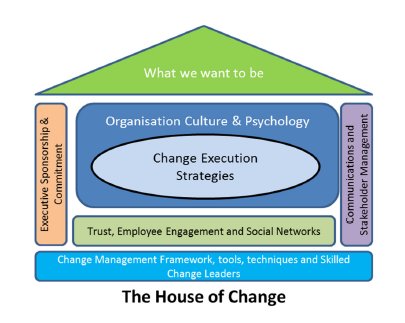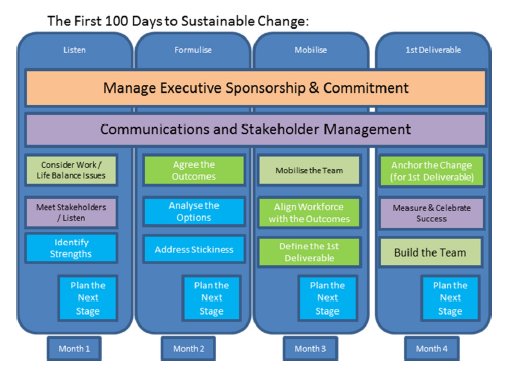The First 100 Days of Sustainable Change
by Chris Phillips-Maund
(UK)

The term "sustainable change" is defined as "the permanence of goals, behaviours, relationships, processes and systems for business advantage following a change".
Demand For Change
Heraclitus 500BC stated 'Everything is in flux', like the constant flow of a river1; 2500 years later Kotter (1996) states "The rate of change is not going to slow down anytime soon. If anything, competition in most industries will probably speed up even more in the next few decades". The demand for change is not going to diminish, certainly not in the short or medium term.
Success of Change
70% of change initiatives fail and this statistic, quoted since the 1990's, shows no sign of improving (Kotter and Schlesinger2, Senge3, Rick Maurer4, Morley5, Blanchard6). This means that a large element of the change effort results in unsuccessful or dissipated change efforts i.e. part of the change outright fails or the outcomes are not sustained in the organisation culture.
There is widespread debate in the change community regarding change management as an art or the rationalisation as a process which the artists argue negates the emotional intelligence aspects that are required to sustain change. Actually, we need to combine these views to provide a holistic view of organisational change and this principle underpins the House of Change.
The House of Change

The foundations of the house of change are the frameworks, tools, techniques and skilled change leaders to be used during the change process. The skilled change leaders must be familiar with the frameworks, tools and techniques available in order to use the appropriate ones given a particular circumstance. There is no silver bullet, no one technique will be fit for purpose for all scenarios. Such tools include appreciative inquiry, collaborative loops, Balanced Scorecard, Six Sigma, Whole Scale Change, etc7. Trust, employee engagement and social networks form the floor of the house and addresses social theory; this gives us firm grounding to walk on and utilises the organisational social strengths and intellectual capital in designing and developing employee-led change.
Trust is multifaceted: trust in the executives to articulate the true organisational problems, without corporate rhetoric or spin. Trust in the change leaders to lead to achieve the agreed outcomes and trust in the employees to own the change. There is a clear objective to eradicate hidden agenda's and information asymmetry through openess. Employee engagement gives the employees the voice and managers the skills to be open to listening to employees.
Executive Sponsorship and commitment and Communications and Stakeholder Management form the walls of the house. Key success factors of change is ensuring executive sponsorship; this does not imply top-down driven change (although in some scenarios, e.g. short-term survival, this maybe desirable) but provides executive voice and support in the organisational power and political structures to acquire or retain required resources.
Communication needs to be targeted, appropriate, timely, and needs to resonant with the audience. All too often communication is distributed too widely losing focus and, hence, loses resonance.
The heart and soul of the house is the organisation culture and psychology and the heart of change is the execution strategies to be adopted to effect the change. The selection of execution strategy must be cognisant of the organisational culture and psychology that exists today and where the organisation wants to be.
All of these aspects of the house are required in order to turn the bricks and mortor of the house into a home and fulfil the outcomes.
First 100 Days
In the first 100 days the House of Change is formed for the particular organisation; opening up the organisation to change and energising the participants to achieve greater step-change.
The first 100 days focuses on participative interactions with executive sponsors and identification and development of change groups to develop the outcomes in terms of goals, relationships, behaviours, systems and processes and the methods and mechanisms to monitor the sustainability aspects of change.
The first 100 days is broken down into 4 month phases Listen, Formulise, Mobilise and 1st Deliverable.
Listen
The key focus here is to identify the key stakeholders, set up change groups and listen to gain an understanding of the organisation culture and psychology.
A key outcome of this phase is the identification of organisational strengths.
Formulise
The formulise phase takes the output from the Listen phase and develops the outcomes, and agrees the change strategies to be adopted to increase the success ratio of change.
Mobilise
The mobilisation phase energises the change groups to execute the agreed change strategies. During this phase a key output is the definition of the 1st deliverable to be delivered in month 4. This fosters the required level of urgency for senior executives and the change groups to celebrate and visualise success.
1st Deliverable
The 1st deliverable is made and the change anchored, through addressing the sustainability criteria.
Through this phase additional attention is given to fostering the social networks and evangelising the change activity to the wider organisation networks by building on the successes of the 1st deliverable.

Two key activities flow through the 100 days Manage Executive Sponsorship & Commitment and Communications and Stakeholder Management. These are the walls of the House of Change.
Benefits:
1. Reduced Business Risk: through increasing the ratio of successful change this reduces the organisational business risk by securing more return per unit invested
2. Reduced Operational Cost: through the reduction of change not meeting expectations, reduction in dissipated change outcomes and reduction in rework
3. Increased Return on Investment (ROI): reducing business risk and operational cost and increasing the ratio of success will result in an increased ROI.
"All of this will not be finished in the first 100 days. Nor will it be finished in the first 1000 days, nor even perhaps in our lifetime on this planet. But let us begin". John F Kennedy Inaugural Address 20th January 1961.
© Chris Phillips-Maund
Download a PDF copy of this article, with references, here:
The First 100 Days of Sustainable Change

